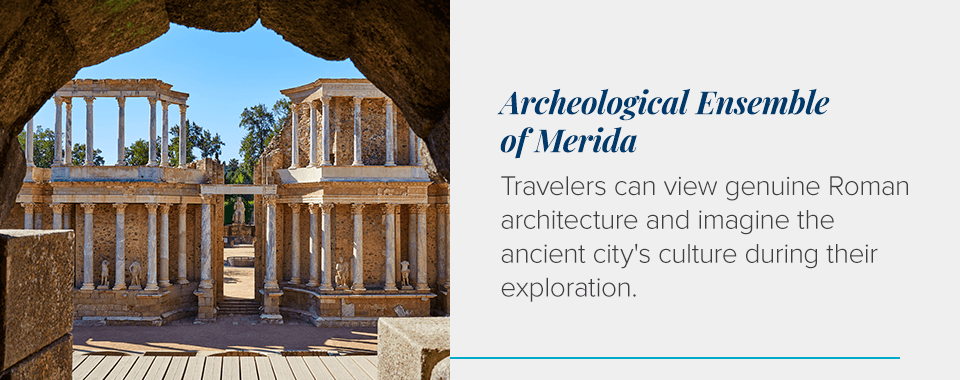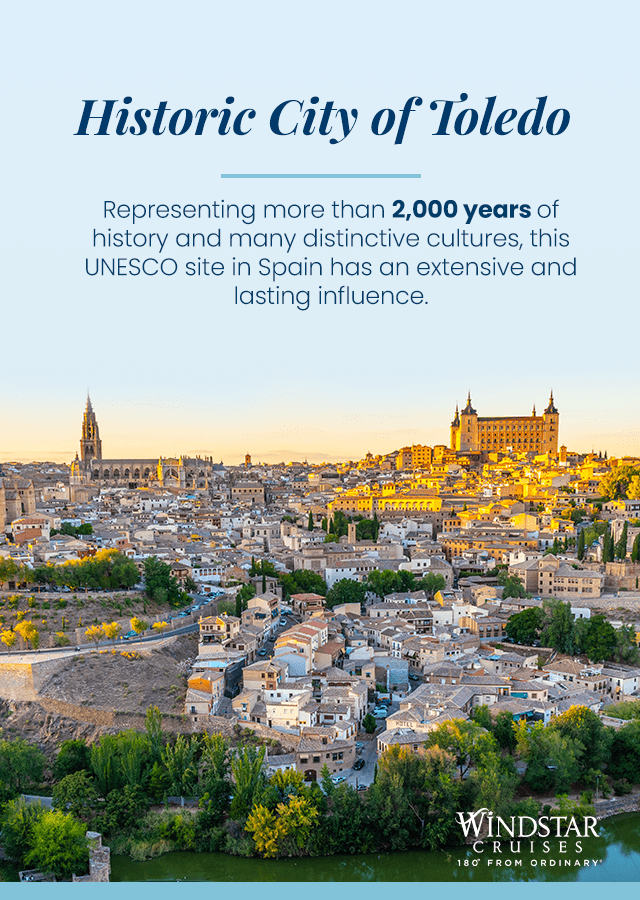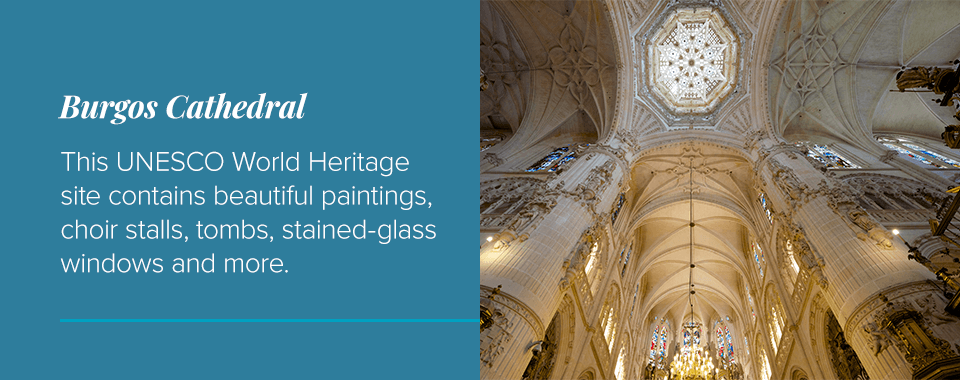
World Heritage sites are designated by the United Nations Educational, Scientific and Cultural Organization (UNESCO) as culturally and historically significant. These locations represent humanity’s contribution to Earth and the features we collectively value. World Heritage sites can be anything from an entire city to a specific river, and they are located all over the world.
The UNESCO sites in Spain display the country’s cultural and natural beauty. From expansive cave art to historic cathedrals, you can find a wide range of unforgettable destinations.
Here are 11 of the best UNESCO World Heritage sites in Spain that you can add to your travel itinerary.
In This Article
- Santiago de Compostela
- Archeological Ensemble of Merida
- Cave of Altamira and Paleolithic Cave Art of Northern Spain
- Works of Antoni Gaudí
- Catalan Romanesque Churches of the Vall de Boí
- Historic City of Toledo
- Las Médulas
- Historic Centre of Cordoba
- Archaeological Site of Atapuerca
- Burgos Cathedral
- Garajonay National Park
- Explore Spain’s UNESCO World Heritage Sites With Windstar Cruises
1. Santiago de Compostela
Santiago de Compostela is a famous Christian pilgrimage site and one of the most important to Christianity. According to legend, a bright star guided a shepherd to the burial site of St. James the Greater. The news of the incredible discovery spread and Christians from all over the world began traveling to the site. Muslims destroyed the city during a religious siege at the end of the 10th century, but over the next century, the town was restored into one of the world’s most beautiful urban areas.
Visitors explore the city’s unique architecture and historic landmarks each year. The Plaza de Obradoiro houses many popular sites, such as:
- Santiago de Compostela Cathedral: This beautiful cathedral is an integral component of the pilgrimage site. It features Romanesque, Baroque and Gothic architectural styles. The cathedral’s crypt houses the remains of St. James and two of his disciples, St. and St. Athanasius.
- Hostal de los Reyes Católicos: This location was once a hospital for pilgrims to recuperate after their long journeys. During the 20th century, it was converted into a luxury hotel that maintained its original architecture. The exterior has pilaster depictions of Christian historical figures like Mary Magdalene and John the Baptist, while the interior contains an expansive courtyard.
- Raxoi Palace: The Raxoi Palace rests in front of the Santiago de Compostela Cathedral. Visitors can admire its magnificent structure as they explore the plaza.
2. Archeological Ensemble of Merida
Another one of the UNESCO sites in Spain is the archeological ensemble of Merida. The city remains were built for the colony of Augusta Emerita in 25 B.C. It served as the capital of Lusitania in the Roman Empire and was intended to show an idealized model of Rome.

Extensive preservation techniques have kept the city in excellent condition. Travelers can view genuine Roman architecture and imagine the ancient city’s culture during their exploration. The property includes structures like:
- Entertainment venues: Visitors can explore the city’s entertainment structures where the Romans used to perform plays or host festivals.
- Engineering works: Many of the city’s original engineered structures are still intact, such as extensive bridges and wastewater systems.
- Religious buildings: You can visit ancient religious sites, like the Temple of Diana. This Roman temple contains raised columns and the remnants of a medieval castle.
- Aqueducts: Aqueducts are one of the Roman’s most notable inventions. These channels distributed fresh water throughout the city. Archeological site of Merida visitors can view the city’s impressive aqueducts, many of which are still in excellent condition.
3. Cave of Altamira and Paleolithic Cave Art of Northern Spain
Northern Spain is home to another UNESCO World Heritage site — the Cave of Altamira. This cave complex houses some of the world’s earliest artwork. An archeologist named Marcelino Sanz de Sautuola discovered the drawings in 1879, leading to a thorough analysis and excavation. Specialists determined the artwork originated from the Paleolithic Age, helping researchers realize people from that period were capable of making artwork and carvings.
The cave art reflects the people’s economic, cultural and social values during the time period. Detailed conservation efforts have preserved the cave art and prevented it from wear or climate-based damage.
Visitors can venture into the cave on a guided tour. The site only allows a limited number of people to enter each week, making prior booking essential. Travelers can also view prehistoric cultural relics and an exact replica of the Cave of Altamira in the nearby Altamira National Museum and Research Centre. You can visit this center for most of the year and immerse yourself in the various exhibits and artifacts.
4. Works of Antoni Gaudí
The Works of Antoni Gaudí site consists of seven buildings constructed by the famous architect in Barcelona and the surrounding areas. The structures display Gaudí’s immense contribution to European architecture, construction and art. Gaudí’s work combined traditional and modern techniques, reflecting a unique style that has awed art enthusiasts for generations.
The UNESCO Spain site includes seven of Gaudí’s structures:
- The Park Güell: This park is one of the largest green spaces in Barcelona. It is a refuge for many plant and animal species and also gives urban residents a way to connect with nature. Some of the internal structures include grand stairways, massive viaducts, colorful gardens and unique buildings.
- The Palau Güell: Gaudí built this mansion between 1886 and 1888 for a politician. Visitors can embark on guided tours to explore the site’s distinctive structure, complete with colorful rooftop chimneys.
- The Casa Milà-La Pedrera: This building is famous for its unconventional, circular structure. Pere Milà and Roser Segimon commissioned Gaudí to build a new property. After many development and legal complications, Gaudi completed construction in 1912. Today, the Casa Mila is a major cultural landmark that hosts many activities.
- The Casa Vicens: The Casa Vicens was Gaudí’s first major architectural work. It was first a summer garden home for a stockbroker and now serves as a museum for the general public.
- The Nativity Façade and the Crypt of the Sagrada Família: This iconic monument was one of Gaudí’s most ambitious projects. Travelers from around the world visit the site to view its Roman-style mosaics, framed altarpieces and other enduring features. Gaudí didn’t get to complete the site before his death, and it still undergoes regular construction work — builders hope to finish it by 2026.
- The Casa Batlló: This building is an iconic Barcelona landmark, drawing in more than 1 million visitors each year. The design features a wide range of various colors, shapes and designs.
- The Crypt of the Colònia Güell: Another unfinished work, Gaudí built this place of worship for people in a suburb near Barcelona.
5. Catalan Romanesque Churches of the Vall de Boí
The Vall de Boí is a steep valley in the Catalan Pyrenees in northern Spain. It’s surrounded by towering mountains and neighboring villages. Each town contains a Romanesque church that depicts the pure architecture and style of the 11th and 12th centuries.
Some of the Romanesque churches include the following:
- Santa Maria de Cardet
- Sant Joan de Boí
- The hermitage of Sant Quirc de Durro
- Sant Feliu de Barruera
- Santa Maria de Taüll
The churches are notable UNESCO sites for their similar structure and development date, as they were all built within the same period of time. All the buildings have undergone restoration and construction to maintain their integrity and well-being.
Vall de Boí visitors can explore the churches while they wander the city. Some sites require payment to enter, while others are free. There is also a central informational site that provides visitors with an overview of each church and how to visit them.
6. Historic City of Toledo

Toledo, Spain, is another UNESCO location. Toledo served as a central landmark for many historical periods — it was the capital of a Visigothic kingdom, the main venue for a Roman Emperor and the site of many political events. Representing more than 2,000 years of history and many distinctive cultures, this UNESCO site in Spain has an extensive and lasting influence.
Years of conservation efforts have preserved the city’s original medieval layout. Toledo is lined with narrow streets and tall, historic buildings. Visitors can wander through the massive cathedral, containing magnificent paintings and chapels. Or, you can explore El Alcazar, one of the highest points in the city. This military museum displays the history of the Spanish army and contains high balconies that overlook the town.
Travelers can also visit various museums, monasteries, synagogues and other noteworthy sites.
7. Las Médulas
Another worthwhile UNESCO World Heritage site in Spain is Las Médulas. This site was an essential gold mine for the Roman Empire in the first century A.D. Romans used an innovative, hydraulic technique to extract gold from the mountains. The Romans worked for centuries before departing the location, leaving behind examples of their technology and approach. The mountainsides still display the mining techniques even centuries later.
Las Médulas consists of mines, tailings, dams and the surrounding area, all vital components of extraction. Complex canals transported water to the mines, breaking down the soil and exposing the gold. The landscape is surrounded by chestnut trees and extensive red rocks, resembling desert landscapes.
Visitors can stay in nearby villages and travel to the mines. You can hike, mountain bike or horse ride through the channels to view the town up close. Various hiking paths range from gentle and flat to steep, rocky hills. An observation platform sits at the top of the mountain, providing an extensive view of the surrounding area. Galleries let you enter the mountains and view the structures up close. Las Médulas is open year-round.
8. Historic Centre of Cordoba
Cordoba is a lively and historic town that exhibits much of Spain’s culture and heritage. This World Heritage site is full of bustling streets, flower-filled courtyards, crowded squares and more. It’s lined with many palaces, public buildings and defensive structures that still hold their original structure today. One of its most famous features is the Great Mosque, which has a rich history tracing back to the 6th century.
The Historic Centre consists of the Great Mosque and all surrounding streets and houses. UNESCO deemed the site culturally significant because it symbolizes different cultures, from initial Roman settlers to the Islamic people that developed the mosque. The city has facilitated the coexistence of Christian, Islamic and Jewish cultures throughout history, showing an enduring unity.
Travelers can wander through the many streets and landmarks, from sweeping towers to detailed museums. Many tourists visit in spring to participate in various festivals and outdoor flamenco shows. You can also try traditional foods and relax in various lodgings.
9. Archaeological Site of Atapuerca
Another UNESCO Spain site is the Archaeological Site of Atapuerca. These caves contain extensive amounts of fossils from some of the earliest humans in Europe, up to 1 million years ago. The fossils provide essential information about early humans’ livelihoods.
Archeologists excavated the site during the 20th century. During this process, the specialists uncovered many artifacts and human fossils that suggested continuous human residence in the area.
Atapuerca is now open for general public visitation, with options to explore the deposits, a nearby archeological center and a Museum of Human Evolution. To visit the archeological site, travelers must book tickets in advance.
10. Burgos Cathedral
The Cathedral of Saint Mary of Burgos exhibits stunning Gothic architecture and centuries of history. Completed between the 15th and 16th centuries, this UNESCO World Heritage site contains beautiful paintings, choir stalls, tombs, stained-glass windows and more.

Development began in the 13th century but stopped for nearly 200 years. It took another 100 years to complete the grand building, including its many embellishments and interior art pieces.
The cathedral’s interior includes the following:
- A golden staircase
- 15 chapels
- A central altarpiece
- An exposition of religious items and artifacts
Visitors can purchase tickets online to visit the popular destination. Its opening hours vary depending on religious services and other events. The cathedral doesn’t offer guided tours, so travelers are free to explore according to their own pace.
11. Garajonay National Park
Garajonay National Park is a thickly forested location on one of Spain’s Canary Islands. It contains many winding streams and springs, allowing for rich vegetation and wildlife habitats. Despite its proximity to the Sahara Desert, it remains healthy and lush. Mild temperatures and abundant water have encouraged vegetation for centuries.
Travelers can visit the nature reserve to view the fascinating greenery, rock formations and plant species. There are many routes, varying in difficulty from beginner to advanced. Various informational centers provide more information about the park’s history and natural life. The park is open 24 hours and only closed on select holidays.
Explore Spain’s UNESCO World Heritage Sites With Windstar Cruises
From archeological sites to historic cities, the Spain UNESCO World Heritage sites exhibit exceptional beauty and importance. You can explore these locations in person on an unforgettable vacation. If you’re ready to plan a Spain trip, book with Windstar Cruises today.
We offer intimate and immersive cruises to Spain and other global locations. Our small ships only carry a certain number of passengers, allowing us to dock at more intimate ports. You can immerse yourself in UNESCO and historical sites in Spain while enjoying a relaxed travel experience.
To get started with Windstar Cruises, browse our available cruises today.




















































